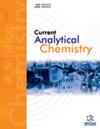七次采收丹参叶中多酚的定量测定及其稳定性评价研究
IF 1.7
4区 化学
Q3 CHEMISTRY, ANALYTICAL
引用次数: 0
摘要
简介采集当年七次采收的丹参叶片作为材料。方法:采用 Folin-Ciocaileu 法和高效液相色谱法测定丹参多酚:采用 Folin-Ciocaileu 法和高效液相色谱法(HPLC)测定多酚含量,以比较样品的质量。研究了在不同条件(光照、温度、pH 值、常见添加剂)下多酚的稳定性:采用 Folin-Ciocaileu 比色法测定不同生长阶段样品中总多酚的含量。采用高效液相色谱法测定不同生长阶段样品中迷迭香酸和咖啡酸的含量。通过测定不同介质(光、温度、pH 值、氧化剂、糖、防腐剂、盐和柠檬酸)中丹参多酚保留率的变化,研究了丹参多酚的稳定性:结果表明,所建立的方法快速、简便、可靠,验证数据充分。采用高效液相色谱法测定总多酚含量,可以快速准确地检测出多酚的含量,减少了人工测定含量的误差。多酚稳定性的研究采用紫外分光光度计(UV),以尽可能探究影响多酚稳定性的潜在因素,使研究尽可能科学、严谨。定量测定结果表明,七个样品中的多酚含量存在明显差异。7 月份采收的样品中总多酚、迷迭香酸(RA)和咖啡酸(CA)的含量最高,分别为 41.37、26.73 和 1.05 mg/g。结论稳定性检测结果表明,光线会破坏样品中多酚的稳定性,尤其是紫外线。多酚对高温相当敏感。虽然多酚在高碱条件和盐处理下的稳定性较差,但在氧化还原剂、碳水化合物和防腐剂浓度较低的情况下,多酚的稳定性要好得多。所开发的方法和稳定性评估为质量评估和后续使用 S. deserta Schang 叶中的多酚提供了宝贵的基础信息。本文章由计算机程序翻译,如有差异,请以英文原文为准。
Studies on Quantitative Determination of Polyphenols in Seven Harvesting Times of Salvia deserta Schang Leaves and its Stability Evaluation
Introduction: Leaves of Salvia deserta Schang at seven harvesting times in the same year were collected as the materials. Method: The polyphenols were determined by the Folin–Ciocaileu method and High-Performance Liquid Chromatography (HPLC) to compare the quality of samples. The stability of polyphenols was studied under different conditions (light, temperature, pH, common additives). objective: The contents of total polyphenols in samples of different growth stages were determined by Folin-Ciocaileu colorimetry. The contents of rosmarinic acid and caffeic acid in samples of different growth stages were determined by HPLC. The stability of polyphenols in Salvia deserta Schang Leaves was investigated by measuring the change of polyphenol retention rate in different media (light, temperature, pH, oxidant, sugar, preservative, salt and citric acid) Results: The results showed that the established method is fast, simple and reliable, which is fully validated in terms of outstanding validation data. High Performance Liquid Chromatography (HPLC) for the determination of total polyphenol content can be quickly and accurately detected, reducing the error of manual determination of the content. The study of polyphenol stability was carried out using a UV spectrophotometer (UV) in order to explore the potential factors affecting polyphenol stability as much as possible and to make the study as scientific and rigorous as possible. The results of quantitative determination showed that there are obvious differences in the content of polyphenols in seven samples. The contents of total polyphenols, rosmarinic acid (RA) and caffeic acid (CA) in the samples harvested in July reached the highest level of 41.37, 26.73 and 1.05 mg/g. Conclusion: The results of the stability assay found that light could damage the stability of polyphenols in samples, especially UV light. Polyphenols are quite sensitive to high temperatures. While polyphenols are less stable when exposed to high alkali conditions and salt treatment, they are much more stable when subjected to low concentrations of redox agents, carbohydrates, and preservatives. The developed methods and stability evaluation provide valuable basis information for quality evaluation and the following use of polyphenols in S. deserta Schang leaves.
求助全文
通过发布文献求助,成功后即可免费获取论文全文。
去求助
来源期刊

Current Analytical Chemistry
化学-分析化学
CiteScore
4.10
自引率
0.00%
发文量
90
审稿时长
9 months
期刊介绍:
Current Analytical Chemistry publishes full-length/mini reviews and original research articles on the most recent advances in analytical chemistry. All aspects of the field are represented, including analytical methodology, techniques, and instrumentation in both fundamental and applied research topics of interest to the broad readership of the journal. Current Analytical Chemistry strives to serve as an authoritative source of information in analytical chemistry and in related applications such as biochemical analysis, pharmaceutical research, quantitative biological imaging, novel sensors, and nanotechnology.
 求助内容:
求助内容: 应助结果提醒方式:
应助结果提醒方式:


